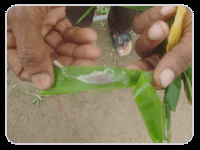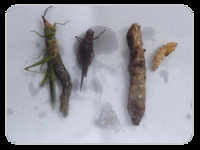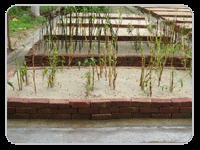Diseases

Bamboo suffers from diseases caused mainly by fungi, which attack the rhizome, roots, culms, foliage, flower & seeds. A large number of saprophytic and parasitic fungi attack the bamboo culms. Felled bamboos are damaged mostly by saprophytic, sap staining and soft-rot fungi. Exposed roots are more susceptible to disease attack.
The most important disease, causing epidemic, is the bamboo blight. This disease has affected Bambusa vulgaris in coastal Odisha during 1985-88 causing large-scale death of full-grown clumps in village groves. It has spread to Odisha from Bangladesh via West Bengal. The blight affects the young culms during or soon after the elongation process starts. The symptoms of the disease are premature death of the culm sheath, which can be easily removed, unlike the healthy ones, and partial collapse of the apical region with wet-rot patches developing on the inter nodes. After rotting of the inter nodes, a variety of insect larvae, beetles ants and aggravate the damage. The dead areas spread rapidly in the tender culm and the apical region dies, ultimately killing the entire clump over a period of 3-4 years.
The casual agent of bamboo blight is a fungus known as Isarocladium oryzae; which is also a pathogen of rice. This disease can be controlled by improved cultural practices and drenching of soil by fungicides. The blighted bamboos are to be cut and removed. Light burning around the clump and provision of earth mounding to the base of the clump, before the monsoon, can improve the clump condition. Treatment of soil (drenching of bamboo clumps) with copper oxychloride and Dithane M 45 has given good results in controlling the bamboo blight.
Insect Pests In India, the pest attack epidemic in standing bamboo crop is not quite frequent nor has raised nay serious concern. However Bamboos are prone to attack by various groups of insects during their growth. Occasionally there is attack by (1) defoliators, (2) leaf rollers, (3) sap-suckers and (4) shot and culm borers. The shoot and culm borers cause more damage to bamboo clumps as compared to other groups of insects. Ghoon & other borers attack the cut and dry bamboos most frequently.
Defoliators A group of insects belonging to Order Lepidoptera and Orthoptera cause damage to leaves. Defoliators & leaf rollers cause the major damage during rainy season leading to foliage loss. It is not easy to use insecticides during the rains for controlling the pests. In case of epidemics aerial spraying can be resorted to in the infested area.
Shoot & Culm Borers The shoot and culm bores, belonging to orders Coleoptera, Lepidoptera and Diptera, mostly damage the tender culm shots. During the rainy season, when young shots sprout, the weevils and beetles become more active and make holes in the tender culms to obtain the sap. They lay eggs below the culm-sheath and the larvae coming out from the eggs, make tunnels through several internodes perforating each node and ending in a hollowed and dead terminal shot. The larvae completely eat out the soft tissues of the young shoots leaving only the culm sheaths. Due to damage of the terminal buds, the juvenile culms may die completely or the basal portion may develop multiple branches of little commercial value.
When older the larvae bore holes in to the soft stem under the shelter of the culm sheath. IN such cases some internodes are perforated but the young shot continue to grow. But latter on the culm may break from the perforated internode before maturity.
The attack is more is congested clumps as compared to well-thinned and worked crops. The normal cultural operations prescribed for working of bamboo such as removal of damaged shoots, thinning of clump to reduce density and exposure of culms to sunlight can control the pest attack to a great extent.
 Pests of felled Bamboos
Pests of felled Bamboos
Borers are the most important pests of felled and dried bamboos. The three species responsible for causing major damage to bamboo during storage and use are : Dinoderus brevis, D. minutus and D. ocellaris.They are collectively known as ghoon borers or shothole borers. They cause immense damage when the bamboos are in the process of drying. Presence of starch, soluble carbohydrates and proteins in the bamboo increases its susceptibility to borer attack. These ghoon borers have 3-4 generations in year. The most active period of borer attack is March onwards. The beetles bore into the cut bamboo through spots where external rind has been damaged. They also bore into the exposed transverse sections of the cut ends and into internal walls of the bamboos. The construct tunnels either vertically or horizontally and reduce the bamboo to dust. The ghoon borers also attack the bamboos even after it has been made in to furniture and mats etc. For protection against ghoon borers both prophylactic methods and preservative treatments are important.
The prophylactic methods are :
 :: Bamboos should be felled when the starch content is at its lowest level i.e. between October to
:: Bamboos should be felled when the starch content is at its lowest level i.e. between October to